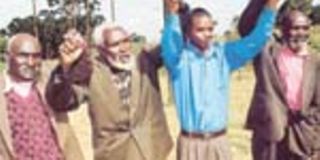The Lari Massacre: Healing the wounds of the fredom struggle

Reconciled at last . . . Former colonial homeguards Paul Mungai Kuria and Douglas Kariuki Wainaina, Lari Memorial Peace Museum curator Samuel Njoroge Waihenya and former Mau Mau gun-maker Daniel Wanjema Kung'u after planting a "peace tree" to show reconciliation at Kereita Forest, Lari Division, Kiambu, on March 26.
The night of March 24, 1953, turned out to be one of the most traumatic in the life of Mrs Annastasia Gaceeri Kahangara. Under the cover of darkness, Mau Mau freedom fighters overan her husband Chief Luka Kahangara's home at Kirenga village, in Lari, Kiambu, murdered him, burnt alive two of his seven wives, and slashed to death his eight children.
The children were hacked to death while the wives, Nyakinyua and Wanjiru, were burnt alive in their grass-thatched huts. The assailants razed the chief's granaries, reduced to shells his lorry and a pick-up vehicle and burnt livestock. Only a pot of brewing muratina (Kikuyu traditional brew) was found standing the following day. Gaceeri watched as her husband and two children were hacked to death. Chief Kahangara was dragged out of his thingira (a grass-thatched hut for a Gikuyu elder), castrated, his eyes gouged out and then beheaded.
Gaceeri was attacked with a machete and suffered more than a dozen cuts on the head, arms, body and legs. Her left arm was chopped off and she was left for the dead. She lived to tell Lifestyle the story of the infamous Lari Massacre or Mwito wa Lari (in Gikuyu language).
Stung by Chief Luka's death, the colonial administration descended on Lari in a revenge mission. The British police (locally known as njoni) were reinforced by the homeguards, the local militias loyal to the government, and Warurungana, the police units made up of non-Kikuyu tribesmen mainly from the Rift Valley. The area was turned into a bloodbath.
Fifty-one years down the line, some of the Lari Massacre survivors, including the homeguards as well as Mau Mau fighters, now reflect on the past with a sober mind.
Gaceeri, Chief Kahangara's fourth wife, saw it all. "It was around 10 pm on Thursday, March 24, 1953. My two co-wives Wairimu, Mbura and I had just gone to bed after heartily chatting the night away with me.
"We were woken up by gunshots and then a gang of machete-welding men broke into the home. They started chopping us up with their machetes,'' she recalls. "The gang of attackers first hurled Mbura out and she fled with her child and my daughter Wanjiku. The other woman followed out as the attackers rained blows on her. My injured daughter cried out to me for help: 'Woi Gaceeri witu!' (Oh my mother, Gaceeri)
"I pleaded with the attackers to spare our lives. I asked them: 'Why are you killing us? I can see you are black people and you speak Kikuyu like me. Why can't you just take me away with you?'
"They shouted back insults at me. My hand was chopped off and dangled from the wrist. I collected my children from outside the house and struggled to hold them both in my arms. I was now praying almost aloud. Then the gang torched my house. I dashed out before the burning thatch could engulf us all inside. I ran towards the bush but fell in the garden. Then I heard a man shout: 'There is another one out there. Chop off her legs!' A group of men pounced on me. They slashed my children to death as I watched. Then they turned on me with pangas and left me for the dead. I was so numb I could not feel pain. I have never felt so cold. The place was so quiet after they left."
From where she lay, Gaceeri saw somebody emerge from the bush.
"It was Muthumbi Ndama, a relative and an employee of mine. I shouted for help. He only cried as he saw the lifeless bodies of my children. I asked him to lift me up and help me move near my burning house to warm my body. But he could not lift me up, I was too heavy for him.
"He brought me two smouldering logs from his burning house. I asked him to disappear quickly just in case the arsonists came back. To date, I shiver when I remember that night. I think that 'chill' is still in me.''
Gaceeri was still conscious when a group of white and African police officers put her and the bodies of her children in a vehicle.
The first stop was Tigoni Police Station, where Chief Makimei Kuria (who would narrowly escape death in a raid by the Mau Mau the following day, March 25), covered her with a blanket to keep her warm.
"We were then taken to Tigoni Hospital where I was stitched hurriedly. I passed out and only came to learn about the deaths of my children, husband and other family members a week later when I regained consciousness at King George Hospital (then the whites-only facility Kenyatta National Hospital).''
Jovial family members
Gaceeri recalls how jovial members of the family had been earlier in the day.
"We had been very happy during the day. My husband had come home at around 8 pm and announced that we all (his seven wives) would go to work on our farm at Ng'enda in Gatundu the following day. He asked us to prepare njohi (beer) which we would carry as was the case whenever we went to work on the farm.''
The women had gathered in the house of the second wife, Kahuria. "We chatted away as we brought water from our respective houses to brew the beer. We then locked up the sheep in their sheds and put the he-goats in the thingira.'' That was the last time Gaceeri saw her husband and co-wives Wanjiru and Nyakinyua alive. Two weeks later, Chief Kahangara was given a state burial.
Gaceeri and other survivors of Lari Massacre were put up in a tent at the Tigoni Police Station. They were then relocated to Bibirioni until the late 1950s when they returned to the farm.
Gaceeri says some of her attackers looked familiar. "I could recognise some.''
Did she forgive them?
Nobody confessed to me
"No one has ever come to confess to me that they cut me up, killed my children and husband. How can you forgive somebody who has not confessed to you?''
She is philosophical: "But I have no grudge against anybody because some of them were family members. It had been prophesied that brother would rise against brother.'' She laments the colonial government "we supported'' did nothing to help the family after the tragedy. "We were attacked, beaten and some killed because we supported the British (colonial) government. But it (the government) did not care much about our welfare.''
However, Njoki wa Kimemia, wife of former Mau Mau activist Kimemia Koigi, has forgiven the homeguards who maimed her on the night of March 26 in a raid to avenge the murder of Chief Luka.
"I have forgiven them as some were members of my (larger) family. I cannot turn away any of them who comes to me for help.''
Her husband used to operate a kiosk at Bathi area near Kimende, and was among the suspects from Lari who were rounded up and held at Lari camp.
The colonial police then swooped on villagers in the area and asked men to step aside.
"I had carried my three-year-old son, Koigi, thinking I would be spared. When the men were asked to step aside, my son jumped and joined them. A policeman wryly told me my baby had clearly indicated who he was.''
The women were frogmarched to Kimende where they were beaten and asked to go on a patrol of the forests to fetch their hiding husbands and relatives. "Some of the women had bottles pushed up their private parts.''
Suffered in detention
Njoki's husband was held at Lari camp and later charged with murder and detained at Manyani. "He died in the early 1960s from injuries he suffered in detention.''
Njoki, 70, says her house was demolished, building stones stolen and cows and five he-goats stolen by homeguards. "God has blessed me. I have a farm and I grow crops and keep some cows.''
However, she laments post-colonial governments have not addressed the plight of former Mau Mau fighters or their survivors. "I have an educated daughter and I have no money to bribe her way into employment,'' she says referring to Esther Wairimu, a single mother of two, who holds a diploma in computer science.
A former homeguard, Douglas Kariuki Wainaina, 73, confesses he led Mau Mau activists to the infamous Kereita Forest killing fields. He showed Lifestyle some Lari Massacre survivors, as well as members of Kijabe Environment Volunteers and Nature Kenya the spot, near Carbacid mine area, where Peter Nightrose, head of the notorious colonial police unit Combat Two, used to shoot dead Mau Mau suspects. The area, then covered by bamboo, now has a variety of beautiful exotic trees.
"I was one of those who moved around the villages with Mr Nightrose fetching Mau Mau men from their homes. We would bring them here in a vehicle. Mr Nightrose would then ask them to escape into the forest. As they dashed away, he would gun them down.'' Among those Wainaina witnessed being killed were former Chief Wanjehia Muthama and brothers Lawrence Gitau Kariuki and Karugari Kariuki.
Regrets being homeguard
He now regrets being a homeguard. "Some of us had thought the white man was too powerful to be defeated. Had we known the truth, we would not have volunteered to work as homeguards. We did not benefit in any way at all.''
He blames the British Government for "enmity among the people of Lari that is so deep we live in suspicion. It has become very hard for us to reconcile and live as one. The colonial government had classified us into 'good' and 'bad' Kikuyu. We the 'good' Kikuyu had a badge to identify us. Today, some of us fear confessing everything lest we are killed."
Wainaina had been warned of the impending government reprisal on Mau Mau by his uncle, Joseph Karuga, who was the head of the local homeguards.
"He told me to spend the night at Matathia Railway Station. From there we could see houses burning. Those who survived the Lari attack were then brought here (the killing filds at Kereita Forest) and shot dead."
Daniel Wanjema Kung'u, 82, had in 1939 taught Mr Nightrose how to shoot in Kikuyu town.
He was Mr Nightrose's father's horse handler between 1937 and 1940. The elder Mr Nightrose would ask him to teach the boy, then aged eight years, how to shoot birds.
A giften artisan
A gifted artisan, Kung'u left the home in 1940 "to get circumcised and get an ID". He was recruited into the Mau Mau and became one of its top gun-makers.
"I was arrested in Lari and detained in Kisumu. Mr Nightrose found me there. He had me released and drove me back to Kikuyu.''
Mr Joseph Kaboro Tumbo, 82, a Mau Mau fighter who did battle for the British Government in India during World War II, survived the Lari counter-attack. "A colonial police officer drove me in his vehicle to the bush to kill me. But he changed his mind on the way when I asked him what I had done to deserve death."




